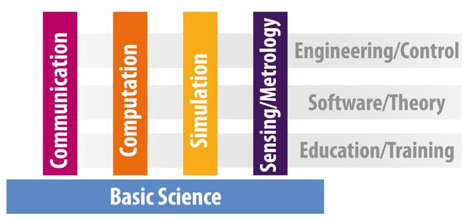Global S&T Development Trend Analysis Platform of Resources and Environment
| First projects selected for the European initiative on quantum technologies | |
| admin | |
| 2018-10-29 | |
| 发布年 | 2018 |
| 语种 | 英语 |
| 国家 | 法国 |
| 领域 | 地球科学 |
| 正文(英文) | On October 29, 2018 the European Union announced the projects selected for the FET Flagship on Quantum Technologies, a European research program of unprecedented scope, with funding of one billion euros over ten years. Its objective is to develop quantum technology applications by strengthening partnerships between research and industry, in the fields of measurement, computation, simulation, and information processing and communication. The EU selected twenty projects, nineteen of which are research projects: ten of these research projects are based on French teams, and among these teams thirteen are laboratories affiliated with the CNRS, while two are coordinated by French organizations, Sorbonne Université and Thales.
Quantum physics has already led to many scientific and technological breakthroughs, including the transistor, microprocessor, and laser, among others. These tools and systems are used on a daily basis by all major companies. A new era has now opened in this field thanks to recent research making it possible to control quantum phenomena, and to thus imagine new technological applications.
In order to facilitate the emergence of these groundbreaking technologies, in 2017 the EU launched a call for projects in connection with the FET Flagship on Quantum Technologies. This program seeks to consolidate the position of Europe, as well as that of the first 224 academic and industrial teams selected, in an international scene that is already highly competitive. The transfer of know-how from European laboratories to industry, along with the technological upgrade of systems, both respond to major scientific, socioeconomic, and societal challenges. The Quantum Technologies initiative is based on four thematic pillars that correspond to various applications of quantum physics: 1) quantum communication, which notably aims to distribute encryption keys proven to be completely secure; 2) quantum computing, which plans to surpass the limits of classical supercomputers and invent the computers of tomorrow; 3) quantum simulation, which aims to discover new medicines, fertilizers, and innovative materials for energy transportation; and 4) quantum metrology and sensing, which is designed, among other things, to explore for mining or petroleum resources, or to analyze the structure of single molecules, with numerous applications in the fields of health and communications. After a very thorough evaluation process, the EU selected twenty projects, nineteen of which are scientific projects in connection with the Flagship, with two of them being coordinated by French organizations:
- On the Quantum Flagship program: https://qt.eu/  © UE Quantum Technologies logo  © UE Quantum Technologies's primary areas of work Download the press release:  Contacts: CNRS Quantum technologies Project Leader | Sébastien Tanzilli | T +33 4 92 07 67 68 | sebastien.tanzilli@cnrs-dir.fr |
| URL | 查看原文 |
| 来源平台 | Centre national de la recherche scientifique |
| 文献类型 | 新闻 |
| 条目标识符 | http://119.78.100.173/C666/handle/2XK7JSWQ/106943 |
| 专题 | 地球科学 |
| 推荐引用方式 GB/T 7714 | admin. First projects selected for the European initiative on quantum technologies. 2018. |
| 条目包含的文件 | 条目无相关文件。 | |||||
| 个性服务 |
| 推荐该条目 |
| 保存到收藏夹 |
| 查看访问统计 |
| 导出为Endnote文件 |
| 谷歌学术 |
| 谷歌学术中相似的文章 |
| [admin]的文章 |
| 百度学术 |
| 百度学术中相似的文章 |
| [admin]的文章 |
| 必应学术 |
| 必应学术中相似的文章 |
| [admin]的文章 |
| 相关权益政策 |
| 暂无数据 |
| 收藏/分享 |
除非特别说明,本系统中所有内容都受版权保护,并保留所有权利。
修改评论